
“All I did was to look at what the universe showed me, to let my brush bear witness to it” -Claude Monet
Claude Monet's Style and Artistic Philosophy by Phuong Nguyen
Claude Monet belong to the Impressionist movement. The reason why they called this group of artists impressionist was because of Monet's piece called Impression,Sunrise. It was submitted for Corporation of Artists, Painters, Sculpteurs, Engravers, etc in 1874 exhibition in Paris. The art critic Louis Leroy rejected the painting and thought the technique to be reckless and unfinished.
Claude Monet was a traveler, which was one of the factors that inspired his many paintings. Monet always tried to find new pictorial motifs; this was why he traveled, not for tourism but for the sake of painting a beautiful motif. Monet’s technique and style of painting are the utilization of strong, pure and unmixed colors developed in 1860s.[i] His brushstrokes are consisted of dots applied onto the canvas in order to produce texture and the effect of light. The dots that the artist applies with a small and short brushstroke are like shattered brushstrokes of colors.[ii] If one is taking a look at Monet’s paintings up close the painting itself is like a pixilated picture. But if one looks at the paintings from afar the dots of colors forms a picture.
Monet start to paint by applying one layer of paint “which varied according to the texture he was trying to suggest. After the first layer of paint is applied other layers that he adds on in specific areas are to arrange “patterns of light and shade.”[iii] Monet claims that his paintings were produced in the outdoors.[iv] Monet finds it easier to paint when he does not have to worry too much as he said, “I’ve always done what I saw without worrying too much about the process.”[v] The more Monet worries about the outcome of the painting the harder it is for him to finish it and thus he can’t complete them.
Nature and the out doors inspired the artist. Monet’s artistic philosophy deals with the change that time makes. He believes that “nature does not stand still” but it changes overtime whether it’s in seconds, minutes, seasons, and years.[vi] Thus when he paints he has to have more than multiple canvases with him to capture the changing of the light and atmosphere of nature. Some of his later series of painting shows this idea of change of light through time. Monet stated “to really paint the sea, you have to see it every day, at every hour and in the same place, to come to know the life in this location. Hence I do the same subjects as many as four or six times over.”[vii] To Monet in order to paint a picture “realistically” specifically landscape one can not paint one canvas because if they do in other words it does not capture the true essence of nature, which is the change of atmosphere and light by the passing of time. Monet believes that when an artist paints they should paint what they see in front of them. He said “when you go out to paint, try to forget what objects you have before you […] Merely think, here is a little square of blue, here an oblong of pink, here a streak of yellow, and paint it just as it looks to you.”[viii]
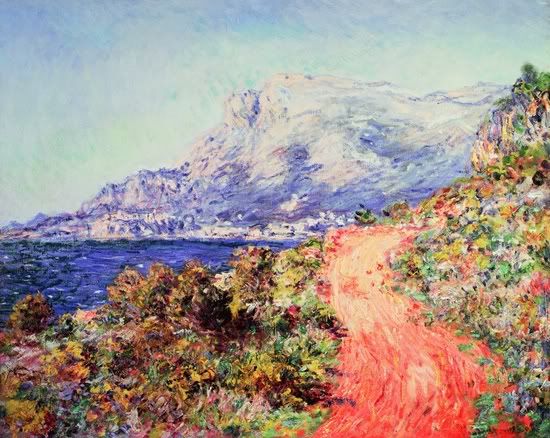
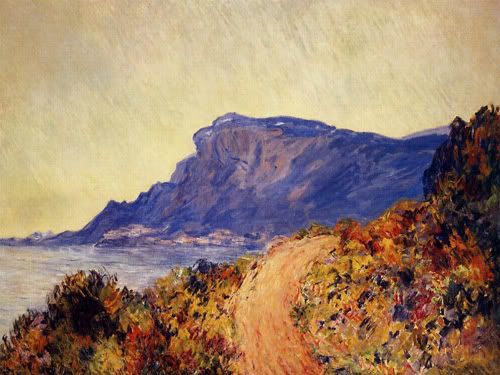
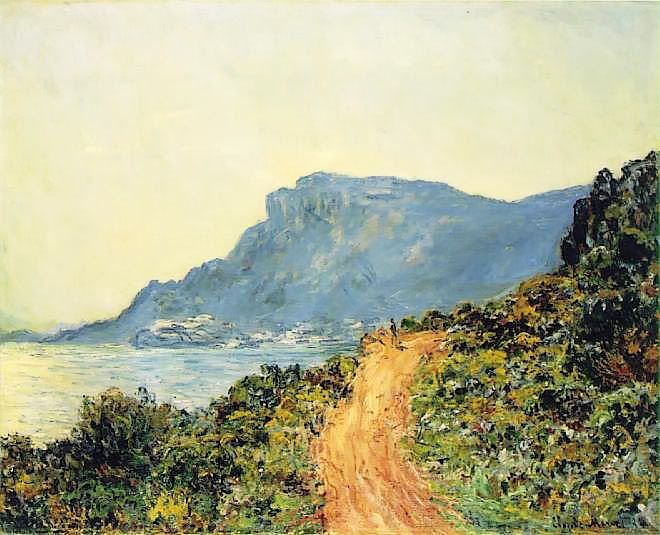

ENDNOTES
[i] Henri Lallemand, “At Le Havre,” Monet Impressions of Light (Singapore: New Line Books), 21.
[ii] Lallemand: 21.
[iii] Henri Lallemand, “A Question of Finish,” Monet Impressions of Light (Singapore: New Line Books),87.
[iv] Lallemand: 87.
[v] Genevieve Morgan, Monet: the artist speaks (New York: 1996), 16.
[vi] Morgan, 40.
[vii] Morgan, 49.
[viii] Morgan, 57.
Historical Context by Pedro Fequiere
Claude Monet moved to the town of Saint Adresse and obtained a “classical” education at La Havre’s secondary school. Around late 1856 early 1857 he began taking pastel and oil painting lessons from Eugene Boudin, Boudin worked out in nature mostly, which encouraged Monet to do the same, he then primarily started working outdoors as well. During the Franco-Prussian war he moved to avoid the war. France lost the war and went through somewhat of an identity crisis, which inspired him to make portraits and good money.
In 1859 Monet moved to Paris to pursue a career in art where he met Camille Pissaro, he sketched and painted her in numerous pieces. She was his favorite model; he went on to marry her in 1870. In 1871 they moved and settled in a village on the Seine near Paris, where he would paint all around the Seine trying to capture his impressions of the interplay of light, water, and atmosphere. In 1874 Monet and a group of painters banded together and formed a society of artists and gave public exhibitions. Being around other artists making the same style of paintings as he did was very influential and only added fuel to his fire. Especially when exhibiting “Impression: Sunrise” at the first Impressionist exhibition. In 1876 he meets Ernest & Alice Hoschede (Whom he went on to marry), and in the following year Ernest went bankrupt, in that year Monet painted the Saint Lazare train station. In 1883 he and his family moved to Giverny, France and rents a house. He then continued to explore his fascination with light in his “series” paintings using the same subjects, like water lilies, pond, and a Japanese bridge in his own gardens. Claude Monet adapted with time and with his surroundings. He has moved around numerous times, making for extensive pieces of work. There is a pattern in when his larger scale paintings were made.
Later Works by Pedro Fequiere
A lot of Monet’s later works were done at the house he rented, which he later purchases in 1890. In 1891 he panted the Meules & Peupliers series. (Haystacks & Poplars) In 1892 he paints the Rouen Cathedrals series. Then later in 1900 he paints the Japanese bridge at several views, and also takes several trips to London and paints views of the Thames. As he aged, he still continued to paint, but he especially kept painting series. After traveling, having problems with his eyesight, and the death of Alice he continued to paint. In 1916 he decides to build a large studio of 23 m x 12 m and from that year until his death he works on twelve large canvas’, which is titled “The Water Lilies.” Throughout his life he continued to work and paint. When faced with trials & tribulations he only seemed to paint more. After loved ones dying he painted even more, and at a larger scale. He didn’t explore new styles of paintings his style remained impressionistic, even when fauvism and cubism were more of the prevalent style at the time. I would say painting for Monet was therapeutic. The only place things would stay the same, because his style didn’t change, and problems he faced only strengthened his works and style.
“Falls Impression” a Claude Monet Inspired Painting by Pedro Fequiere
Claude Monet tried to capture the influence of light on an object, a lot of his works were done outdoors and his subject matter was a garden he would frequent, containing flowers, trees, and a Japanese bridge. I rendered a very bright landscape with good contrast. It’s very painterly and you can see the individual brush strokes. With grass being the foreground, water being the midground, (inspired by his series of paintings done at the Seine) and trees being the background.
[i] http://giverny.org/monet/biograph/
Monet, A Progression of Painting
by Jessica Seyfang
By looking at his most famous works today, it may be hard to believe that Claude Monet’s most early works in childhood were charactures of local notables in his hometown. From this, he gained the attention of many people, despite his father’s lack of support. It was Eugene Boudin who first introduced Monet to the world of landscape painting around 1856. Soon after their time spent together, his first Salon submissions in 1865 were studio enlargements of smaller paintings that were partially done outside. These highly rendered and Courbet-like rich dark colors along with highly rendered brush strokes show the influence of other artists on Monet, including Boudin and Jongkind. These early works lack his trademark aspects of fleeting light and attention to shadow, which make up his later work. When talking about his paintings much later in his life, Monet told his biographer, the Duc de Trevise, “When I began, I was like the others, I thought that two canvases were enough, one for dull weather, one for sunshine.” (i)
The fist glimpse of Monet’s unique painting style coming to life can perhaps be seen in his group of paintings done at Le Havre in 1866. In these, he used small brush strokes to create texture and suggest highlights of the light in the scenery of trees. It wasn’t until October of 1869 that Monet and Renoir began to paint in the style that we know today as Impressionism. In order to create the high keys of their palettes, they used canvases that were not prepared with the usual warm brown or red overlay; instead they used ones prepared with white or pastel tone to enhance the luminosity of scenes depicted. Both Monet and Renoir used a wide range of vibrant colors, in an attempt to show the image on canvas, as it would appear on the retina of the eye. (i) Thus the tendency to show immediate impressions, more so than the permanent aspects of a subject, was born. Brushstrokes are both wet and dry but still share a unified theme of showing direction and wide variety of hues, which creates a fleeting effect on light and the overall airy feeling of each piece. His travels not long after this, to various places in the Mediterranean, inspired paintings of the landscapes there and with this, Monet’s sense of personal unique style was reinforced and progressed.(ii)
Late in the summer of 1890, Monet started a new era in his painting career. He had begun his series paintings, which would occupy him through to the end of his life. (ii) He played close attention to the effects of light and often studied the same exact scene in different ways. An example of this is his series of grainstacks, which he showed at various times in the year. Here his brushstrokes are soft and have an airy quality, the bright vibrancy of color creates emotion and gives a unique mood to each work depending on the color usage. Monet exaggerates the effects of light and atmospheric color. He used this same concept with other subjects such as the poplars and poppy field.
From his early works, to his later ones, Monet definitely progressed as an artist and was persistent with his goals. He painted through and experimented with different styles until he found his own niche and way of painting. It seems that most of his life,Monet was in search of understanding color and light and its hypnotic movement in the world around us, its ability to shape a scene and capture a moment. As he once stated, “Colour is my day-long obsession, joy and torment.” (iii) Even when his vision troubled him in his later years, he kept on painting until the end.
End Notes
(i) Lallemand, Henri. Monet, Impressions of Light.New Line Books Limited.
(ii) Pissaro, Joachim. Monet and the Mediterranean. Rizzoli in association with the Kimbell Art Museum. Fort Worth, Texas. 1997
(iii) Art Quotes.net. 3 November 2009
<http://www.artquotes.net/masters/monet-claude-quotes.htm>.
(iiii) Web Museum, Paris. Monet Claude. 19 September 2002 <http://www.ibiblio.org/wm/paint/auth/monet/>.
"Abandoned Leaves" by Jessica Seyfang
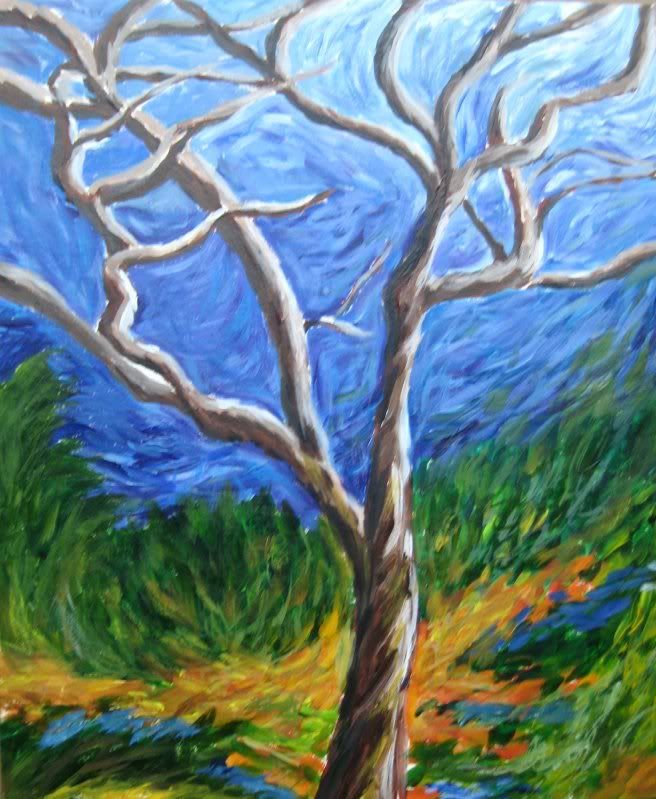
This Painting was inspired by Monet’s five paintings of olive trees, especially one entitled Study of Olive Trees. In these pieces, Monet focuses on the way the light filters through the leaves of the trees and also calls attention to the twisted forms of the branches and trunks and the various highlights and shadows they contain. Monet displays the contrast of chroma between the silvery pale blue light on the leaves and the crimson touches of the clay ground.
In my painting, I have pictured a tree that I came upon while walking on campus. I was particularly interested in the twisted branch forms and the formation of fallen orange leaves that scattered the ground underneath it. Similar to Monet, I tried to use my brush strokes to suggest light and movement. I also played up the contrast of color between the bright vibrant leaves and the more neutral blues in the sky.

Monet's "Grainstacks in the Sunlight, Morning Effect"
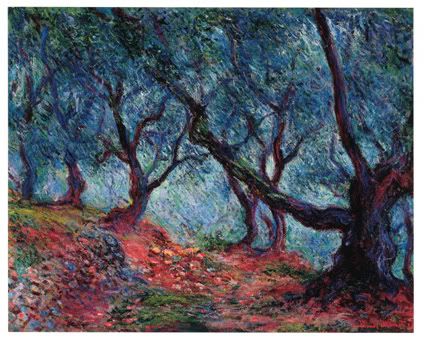
Pissaro, Joachim. Monet and the Mediterranean. Rizzoli in association with the
Kimbell Art Museum. Fort Worth, Texas. 1997
Art Quotes.net. Claude Monet Quote. 3 November 2009.
<http://www.artquotes.net/masters/monet-claude-quotes.htm>.
Web Museum, Paris. Monet Claude. 19 September 2002. 4 November 2009
.jpg)